
The recent negotiations in Tashkent with the participation of a delegation from Chinese leather companies marked a pivotal moment not only for bilateral industrial relations but also for regional cooperation in Central Asia.
The Chinese delegation continued its business mission with a meeting at the Ministry of Investments, Industry and Trade of Uzbekistan, joined by representatives from the Uzcharmsanoat Association and local manufacturers.
Focus of the talks — from priorities to practical steps
The discussions focused on key areas of cooperation: investment, sourcing, joint ventures, technology transfer, and export logistics.
Unlike traditional capital injection, the Chinese side proposed a production-based partnership model, emphasizing:
Uzbekistan, in turn, offered government-level support, tax and customs incentives, and fast-track licensing procedures for investment projects.
Sourcing model — structured production partnership
One of the most innovative proposals was the sourcing model, where Chinese firms place production orders with Uzbek manufacturers according to Chinese standards.
This model ensures market stability for local producers, diversifies product lines, and introduces new technologies.
From vision to action: concrete joint projects
The partnership talks included discussions of specific pilot projects, such as:
Both projects foresee the development of new production units, quality control labs, and job creation.
Knowledge exchange and workforce development
The Chinese side expressed interest in contributing to training programs and co-development of product design with local talent.
To turn cooperation into real business, export access and logistics are essential.
This visit was more than a formal meeting — it was the beginning of a strategic industrial alliance rooted in trust, shared goals, and action.
The growing partnership between Tashkent and Beijing in the leather industry represents not only new investment and technologies but also Uzbekistan’s increasing role as a reliable industrial player on the regional stage.
Uzcharmsanoat